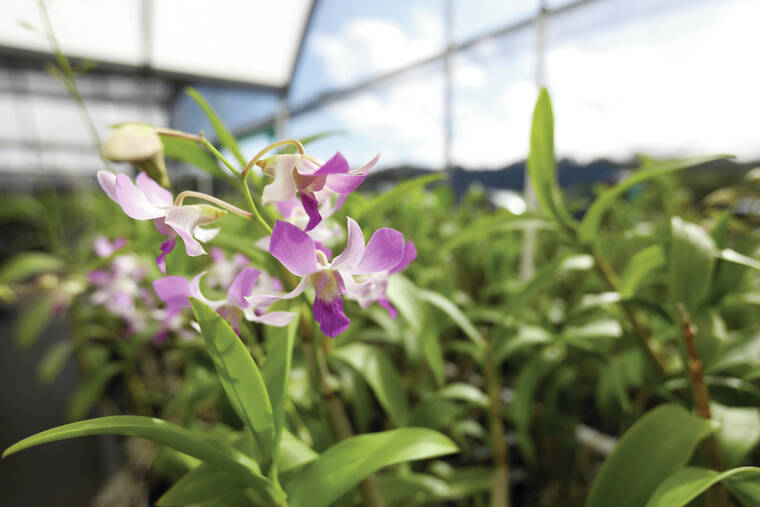The power of flowers

Kelsey Walling/Tribune-Herald A single orchid has bloomed and grown in the Puna Flower Power greenhouse in Keaau on Tuesday.

Kelsey Walling/Tribune-Herald Gordon Inouye, right, and Joe Kekedi talk about working in the Puna Flower Power orchid greenhouse on Tuesday.

Kelsey Walling/Tribune-Herald A single orchid plant blooms among thousands of other orchids in the Puna Flower Power greenhouse in Keaau on Tuesday.

Kelsey Walling/Tribune-Herald Gordon Inouye talks about orchid farming outside the Puna Flower Power greenhouse in Keaau on Tuesday.

Kelsey Walling/Tribune-Herald A single orchid plant blooms among thousands of other orchids in the Puna Flower Power greenhouse in Keaau on Tuesday.

Kelsey Walling/Tribune-Herald Gordon Inouye inspects growing orchid plants in the Puna Flower Power greenhouse in Keaau on Tuesday.

Kelsey Walling/Tribune-Herald An orchid has bloomed and grown in the Puna Flower Power greenhouse in Keaau on Tuesday.

Kelsey Walling/Tribune-Herald Gordon Inouye admires an orchid bloom in the Puna Flower Power greenhouse in Keaau on Tuesday.
KEAAU — The chief executive of a small but budding orchid-growing cooperative compared the company’s formation to “a phoenix rising out of the ashes.”
KEAAU — The chief executive of a small but budding orchid-growing cooperative compared the company’s formation to “a phoenix rising out of the ashes.”
Gordon Inouye, president of Puna Flower Power, noted that much of the Big Island’s commercial orchid industry was centered in Kapoho. All but small pockets of the lower Puna village were inundated by lava in the 2018 lower East Rift Zone eruption of Kilauea volcano.
ADVERTISING
Especially hard hit were the area’s farmers, including orchid growers. The flower industry in Puna took an estimated $30 million hit, according to a community project funding request on the website of U.S. Rep. Kai Kahele, a Hawaii Democrat.
“After the devastation, there were a lot of proposals by public officials and elected officials about opening up a new orchid park. But practically speaking, those things take an awful lot of time,” said Inouye, who with his brother, Vern, owned the former Puna Orchids.
Inouye decided leasing private land to rebuild the industry was a quicker way to go, so he approached then-W.H. Shipman Ltd. President Bill Walter — who was set to retire from the family-run, Keaau-based company in December 2018. Walter introduced Inouye to his cousin, Peggy Farias, who assumed the helm of the Big Island’s fourth-largest private landowner.
“Peggy and I worked along with her cousin, Oliver English,” Inouye said, referring to Shipman’s director of agricultural operations. “And so we mapped out a new orchid park on about 50 acres along Railroad Avenue.”
“We got all the orchid growers that we could,” he continued. “We invited them to a meeting, but the growers all had a million and one questions: Where’s the money going to come from? How are we going to build the infrastructure? All of which weren’t answered.
“And most of them were so dejected and defeated, they weren’t interested in going forward.”
A few of the displaced growers, however, still wanted to start over. They included the Inouyes, Joe Kekedi, Elton Mow and Lee Nishimoto. That prompted Gordon Inouye and Shipman’s leadership to devise a scaled-down plan which included forming a cooperative.
“Oliver English came up with the idea, ‘Would the bottom of a quarry be suitable for an orchid nursery?’ And I said, ‘Of course, it would,’” Inouye recalled. “Once you remove rock and you’ve got a big hole in the ground, what do you do with it?”
And so the co-op leased six acres of previously excavated land owned by Shipman at the Puna Rock Co. quarry on Milo Street in Keaau.
“We all agreed it would be a perfect site for a nursery, so we worked with Puna Rock and Shipman,” Inouye said. “Shipman gave us very favorable rates that I’m not at liberty to disclose.”
Puna Flower Power applied for and received a $500,000 Kilauea Recovery Grant from Hawaii County, as well as a $479,870 low-interest loan from the state Department of Agriculture earmarked for the 2018 lava disaster. A $10,000 grant from the U.S. Department of Agriculture financed the purchase and installation a photovoltaic electrical system with storage batteries.
“We use it for our irrigation pumps, domestic water pumps, and also for the controller for the irrigation,” Inouye said.
There are now three greenhouses, each with 19,320 square feet of space — room to grow 150,000 orchids per warehouse. One is already growing marketable potted plants that are being sold to other retailers and vendors at the Hilo Farmers Market. All of the greenhouses are expected to be fully operational within the next few months, Inouye said.
According to Inouye, Puna Flower Power currently is growing three types of orchids: dendrobiums, oncidiums and cattleyas.
Kekedi, Puna Flower Power’s vice president, came up with co-op’s catchy name. He said it has nothing to do with 1967’s Summer of Love in San Francisco and the “flower children” culture it fostered.
“I raised my family out of flowers,” said Kekedi, who was born in Hungary and spent 13 months in a refugee camp in Austria. Kekedi said that after punching his ticket to the U.S., he spent 18 years as an auto body repairman.
“When I came to Hawaii, I fell in love with nature,” he said. “I said to myself, ‘These are living things,’” and pointed to a row of orchids. “Cars are beautiful, don’t get me wrong, but I came to the realization that I love a good tractor better than a 911 Porsche.
“I’m proud of the fact that I’m a farmer. I have three kids raised in Puna — born on the farm, not even in the hospital.
“For someone like me, being a refugee from a communist country, I live a dream lifestyle.”
Email John Burnett at jburnett@hawaiitribune-herald.com.


